Bees are an excellent illustration of stinging insects that are crucial to Tennessee’s ecosystem. Bees, which currently number between 16,000 and 20,000 species, are beneficial for a variety of reasons. These buzzing critters create honey, which is their main contribution to society, but they also carry out a variety of other tasks.

Critters like these pollinate plants that yield food for both people and other creatures. Despite not all of them having the ability to sting, bees are extremely territorial and will attack when threatened.
Not all bee stings feel the same. Below we’ll talk about the famous sting pain index chart created by Dr. Schmidt. Following that, you’ll be able to look at some of the most prevalent and harmful bees in the great state of Tennessee!
Schmidt Sting Pain Index
Entomologist Dr. Justin O. Schmidt developed the Schmidt Sting Pain Index. Dr. Schmidt spent more than ten years exposing himself to insect bites and stings while writing almost poetically about what he learned.
Schmidt didn’t start out wanting to specialize in bites caused by insects. He is an expert on hymenopterans, an order of insects that includes ants, bees, wasps, and their relatives. While collecting samples in the real world, Schmidt inexorably came into contact with a variety of unpleasant pinches, stings, and defensive measures.
Eventually, he put together a scale of more than 70 distinct stings, rating them from zero for irritation to four for extreme pain. So, which bee sting causes the most pain, in Dr. Schmidt’s opinion? Are the most harmful bees among the scariest ones? How painful are their stings? Let’s take a look.
14. Squash Bees
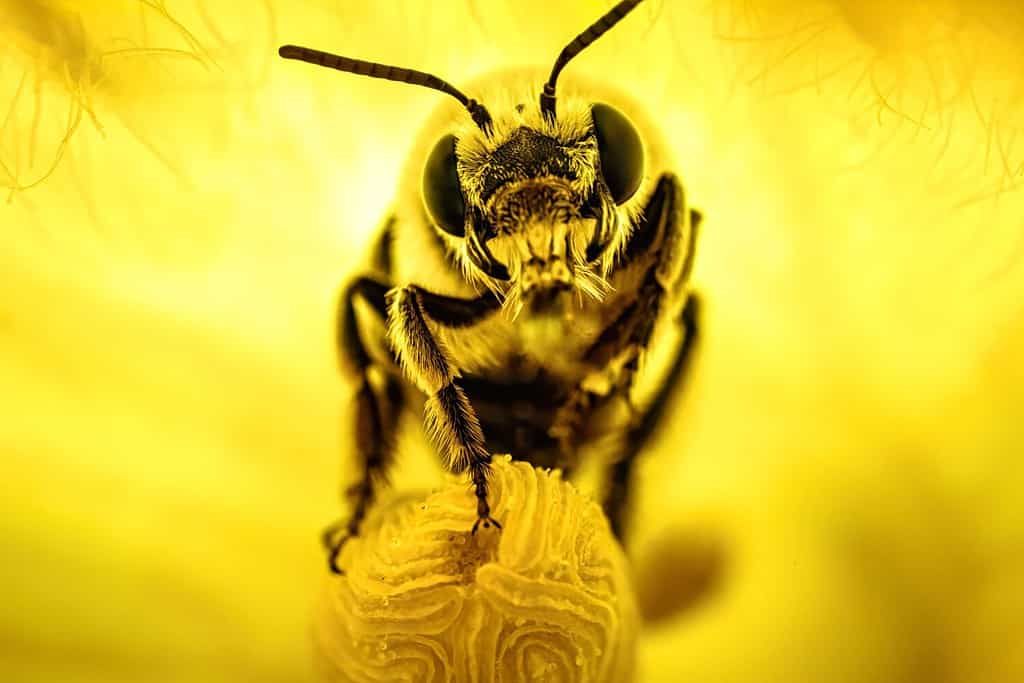
While they may sometimes be mistaken for honey bees, squash bees are a bit larger and thicker.
©Joseph Burdick/Shutterstock.com
A common and crucial pollinator is the unassuming squash bee (Peponapis pruinose). It frequently passes for honey bees. They differ from honey bees by having a somewhat larger size and a thicker form. Compared to honey bees, they also have broader faces and longer antennae.
It has been demonstrated that squash bees are effective pollinators of many squashes, including acorn and zucchini. This species builds underground nests. They don’t have stingers, so they don’t represent a threat to sting people.
13. Sweat Bees

The sting of a sweat bee is mild. That’s good, too, because they’re drawn to perspiration, and will come after your sweat in the summer.
©Barbara Storms/Shutterstock.com
Starting us off with the least painful sting are sweat bees! Sweat bees are drawn to perspiration, as suggested by their common name. These buzzers will come and eat our sweat as we work in the garden.
Although they occasionally sting when swatted, their venom frequently just causes minor discomfort. Both metallic and non-metallic bees are seen in sweat bees. While the majority of sweat bees in Tennessee are drab to metallic black in appearance, a number of the more widespread and easily recognizable varieties are shiny green or blue.
Many sweat bees build their nests underground on empty land that is subjected to the sun, similar to many of Tennessee’s native bee species. Yet, certain species are going to lay their eggs in other species’ nests while some are cleptoparasites that do the opposite.
12. Mason Bees
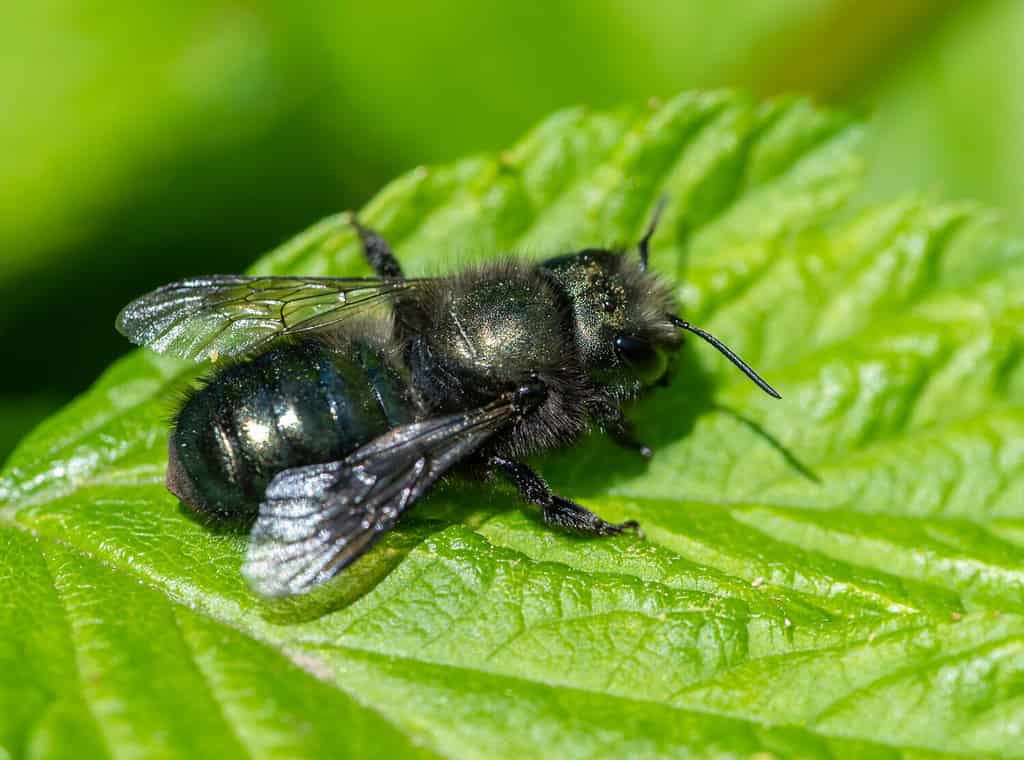
Since they’re not aggressive, mason bees generally don’t sting.
©Jennifer Bosvert/Shutterstock.com
Mason bees, often referred to as masonry bees, are native bees, which means they develop natively in a particular area. They get their name from the materials they collect to construct their homes.
Mason bees are solitary, tunnel-nesting pollinators, unlike honey bees, and they frequently employ mud or clay to plug the holes in their houses. This nesting shouldn’t be ignored when near a structure because it could eventually harm the structure. The tunnels and holes can let water into the building and cause serious damage.
Mason bees. seldom sting and are not aggressive. Squeezing these buzzers is one of the only ways to make it sting, and even then, it usually won’t.
11. Digger Bees
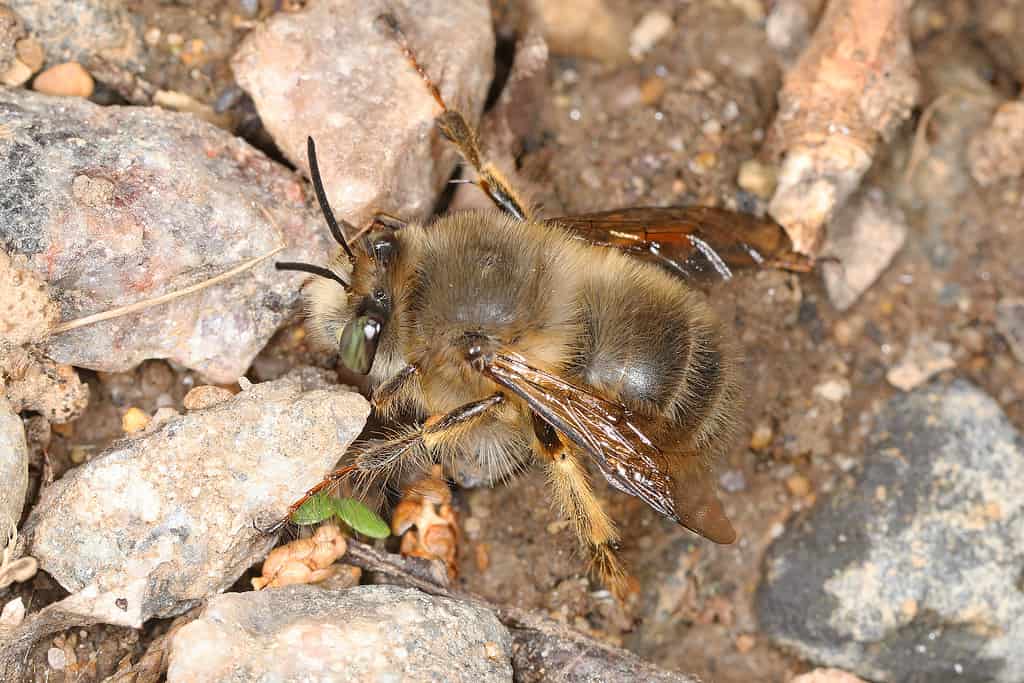
While 70 species of digger bee live throughout the United States, up to 400 of them exist over the world.
©Judy Gallagher / Flickr – License
Digger bees, often called earth bees, are solitary bees that build their nests underground. About 70 different species of digger bees live throughout the United States, including Tennessee.
400 species of these fascinating critters are thought to exist worldwide. In sections of your yard with little grass, like dry or gloomy spots, you might see digger bees. The bees, which are only present for a short time in the early spring, are advantageous because they pollinate crops and eat dangerous insects.
You ought to be free from disturbances and the fear of being stung while working in your yard or cutting your grass if you have these little buzzers hanging around.
10. Polyester Bees
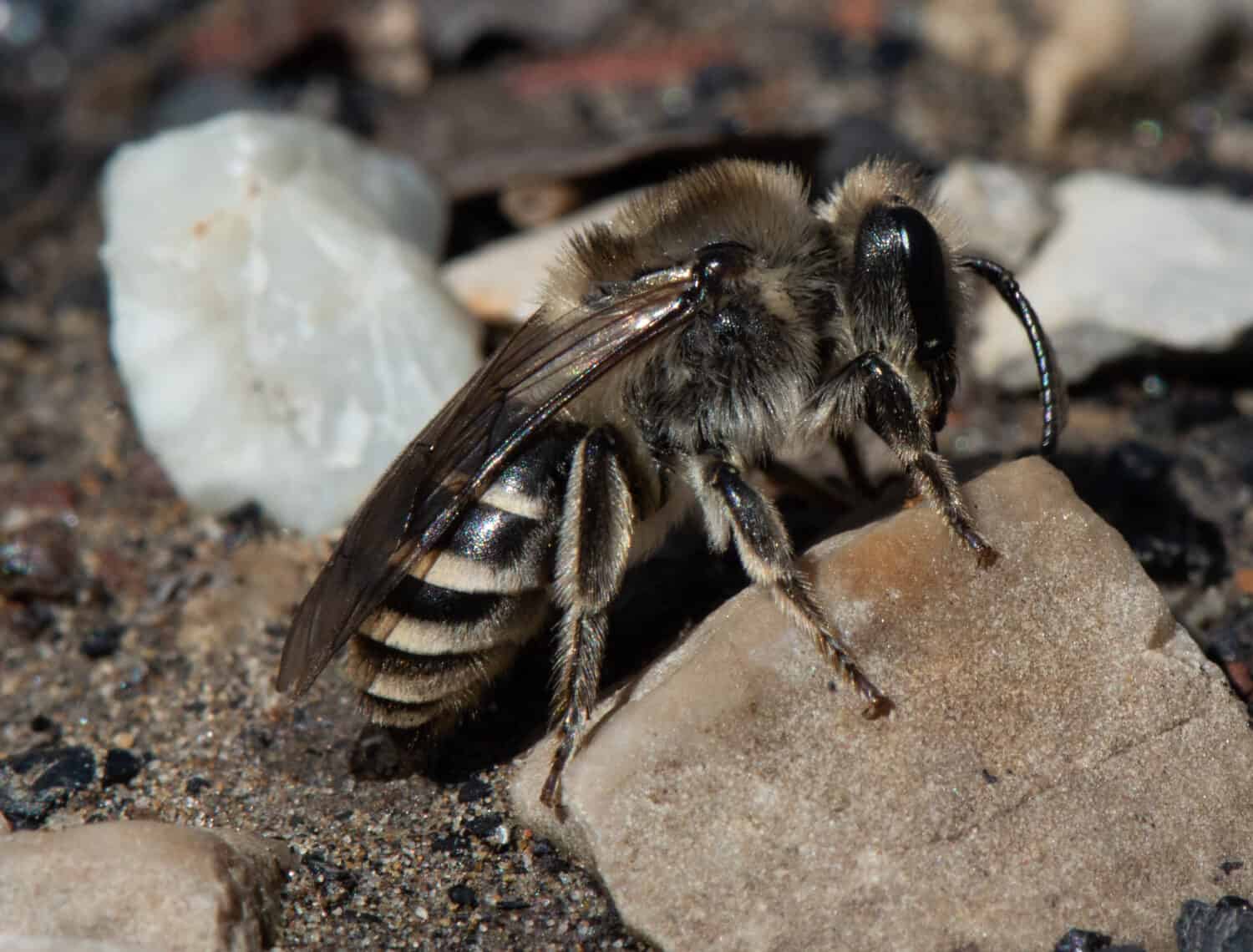
Most after at dawn and dusk, you might see polyester bees collecting pollen at these times.
©Melinda Fawver/Shutterstock.com
Because the bees of these species are expert pollinators, they only visit one kind of flower for nectar and pollination. Each species has a particular, preferred type of flower. They are solitary and lay their eggs in the earth.
Polyester bees are crepuscular, which means they are most active at dusk and dawn. Throughout the summer, watch for them fluttering between flowers and collecting pollen after dusk. Rarely do these bees attack humans. In order for one to sting you, you would essentially need to sit on one.
9. Leafcutter Bees
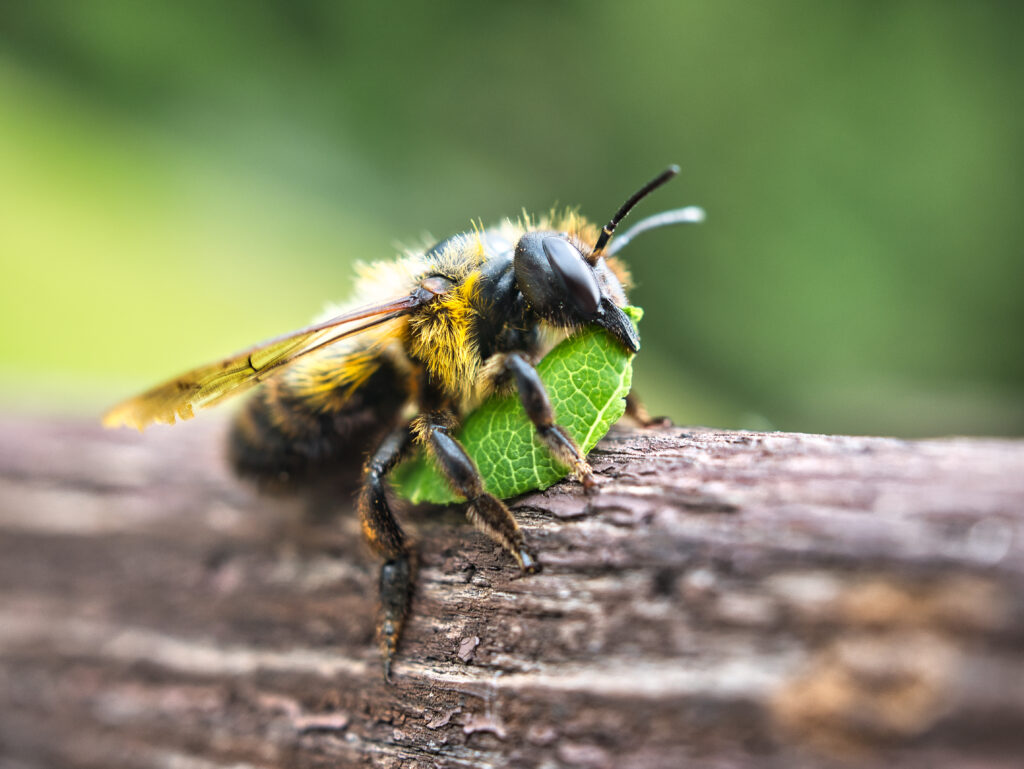
If you see round holes around the outer edges of your plants, you may have leafcutter bees living near.
©Maurice Lesca/Shutterstock.com
Leafcutter bees use tiny leaf cutouts to fill the nest cells in their hives. It is believed that this keeps the pollen and nectar from drying up before the eggs can hatch. You might have several leafcutter bees living around if you notice round holes along the outer edges of your plants.
Usually, they construct long, narrow tunnels with distinct spaces for each egg to nest in the soil or decaying wood. Compared to certain other varieties of bees, they have enormous oval eyes that resemble flies.
Since they are not violent, leafcutter bees only sting when threatened. The pain from their sting is significantly less than that of some of the bees further down this list!
8. Miner Bees
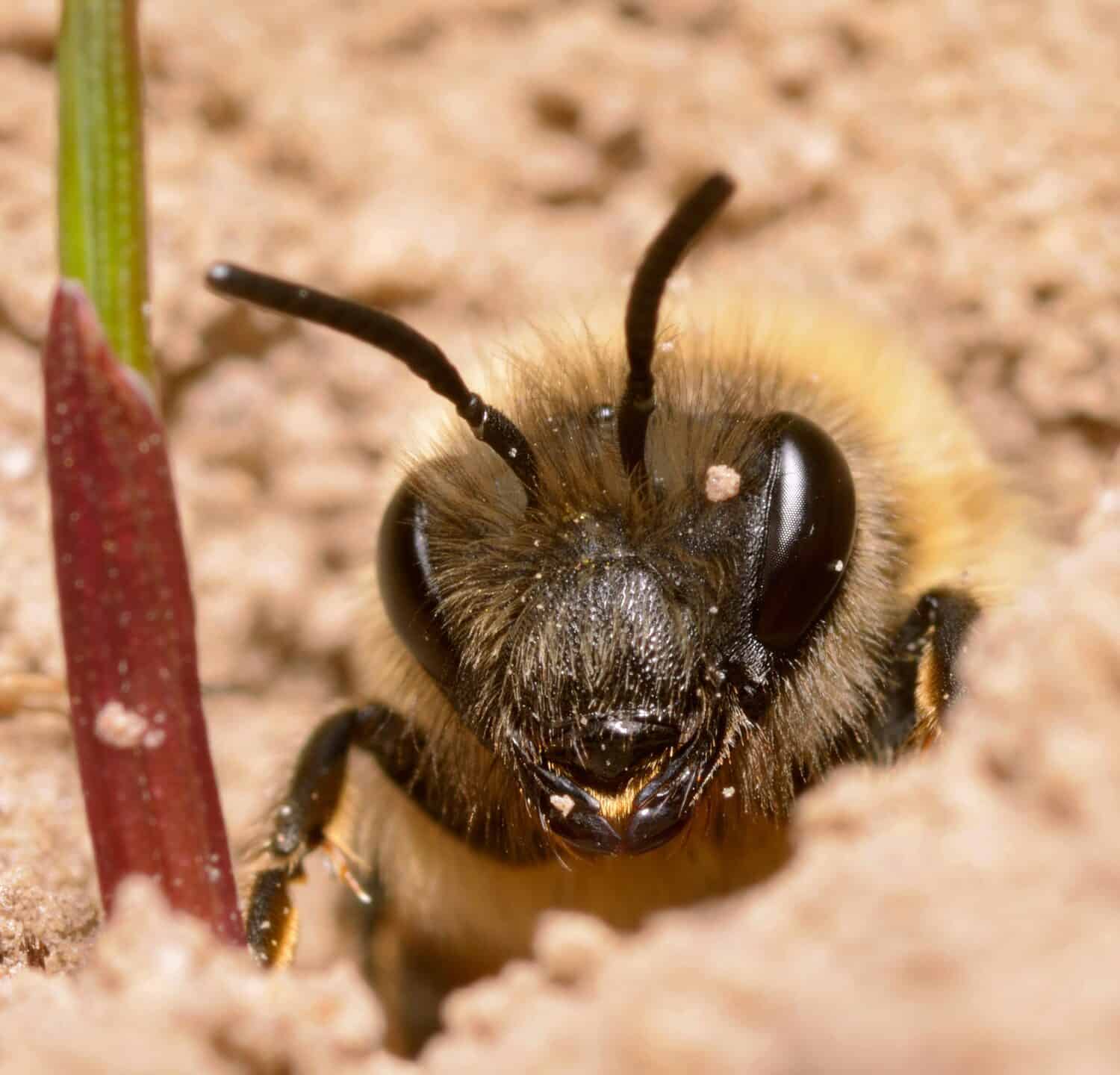
With their hairy bodies, many mistake miner bees for bumble bees.
©Krysja/Shutterstock.com
Miner bees, commonly referred to as chimney bees, have robust, hairy bodies and are smaller than honey bees. They are frequently misidentified as bumble bees. They usually don’t sting or bite and are amiable and non-aggressive.
Miner bees have the ability to sting, however, they do it relatively infrequently and exclusively to guard their eggs. Their stings don’t hurt too much though; according to the Schmidt Sting Pain Index, they barely register one out of four.
Mining bees are incredibly helpful insects in gardens. Due to their intricate nesting habits, miner bees are the most widely recognized and extensively studied. Miner bees are isolated, ground-nesting insects that prefer to build their nests in banks, mountains, and roadsides where well-drained soils, such as clay, are prevalent.
7. Small Carpenter Bees
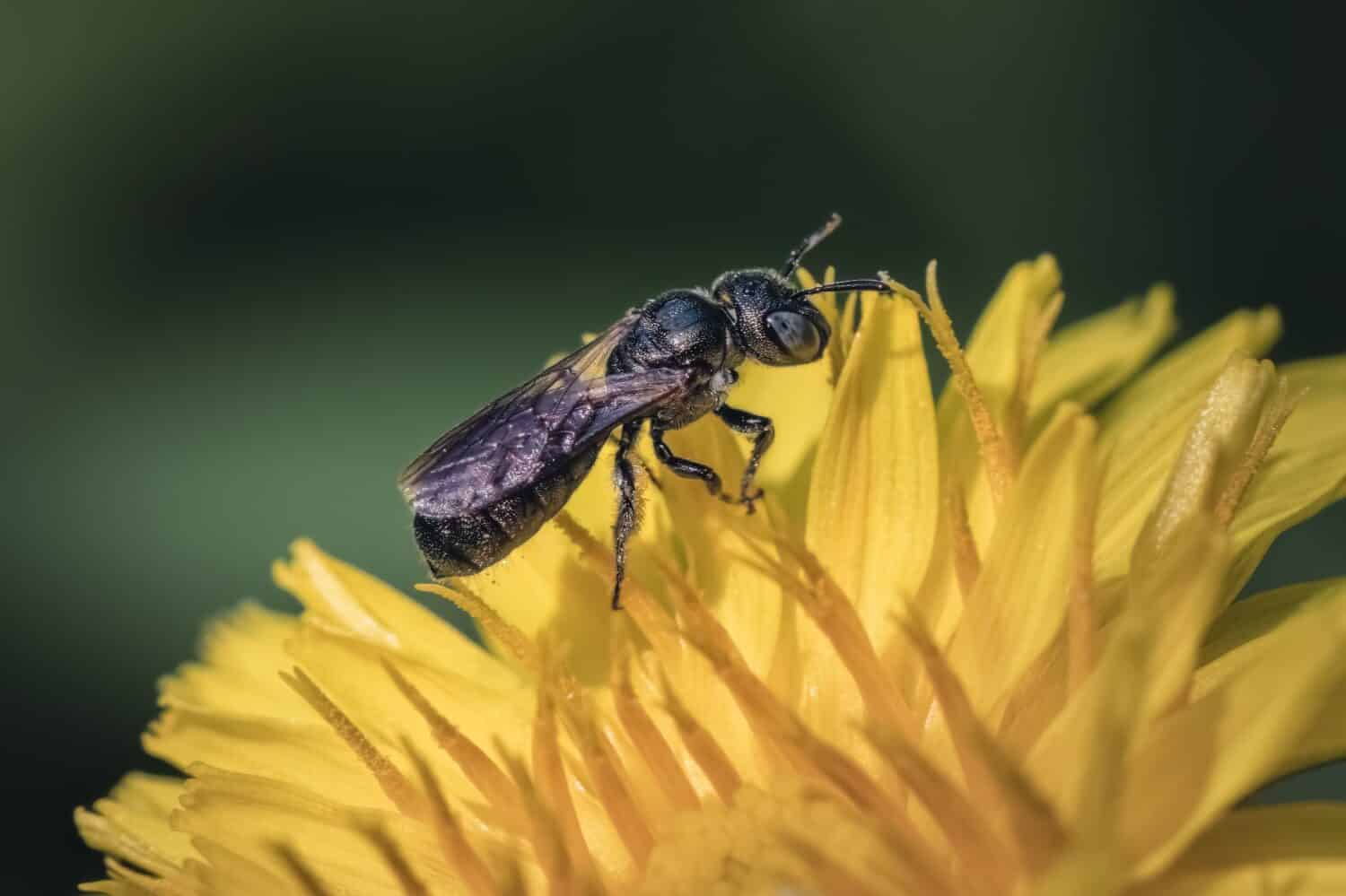
Female small carpenter bees collect pollen and nectar from the blooms of at least 25 plant families.
©Victoria Virgona/Shutterstock.com
The Ceratina genus of little carpenter bees has black bodies with blue, bluish-green, or white accents. On the forehead, thorax, and legs, they may have markings that are light yellow. There have been reports of small carpenter bees building their nests in the damaged stems of weeds, rose bushes, and sea oat stems.
In at least 25 different plant families, including the rose, blackberry, and Marguerite daisy, females collect pollen and nectar from the blooms. They don’t have a particularly painful sting, especially when compared to a large carpenter bee, but more about them later!
6. Cuckoo Bees

Because the hairs on their bodies are so small, cuckoo bees look like wasps.
©Geza Farkas/Shutterstock.com
Cuckoo bees don’t resemble “classic” bees because they have little body hair, and because of this, they could be mistaken for wasps. In order to protect themselves from advancing workers while they break into the nest and murder the host queen, they must also be skilled fighters.
As a result, cuckoo bumble bees have thicker, more potent stings, larger, stronger mandibles, and a hardened abdomen. The infiltrating cuckoo must diffuse a conflict after breaching a nest before assimilating into the host colony.
By imitating the chemical cues employed by their host species, certain cuckoo bumble bees achieve this. The few identification compounds that other cuckoos make help them to pick up the “scent” of the colony when they come into contact with nest components and workers.
5. Masked Bees

With white or yellow markings splashed on their faces, masked bees look like they wear masks.
©Jaco Visser/Shutterstock.com
The moniker “masked bee” refers to these bees’ striking facial yellow or white markings. This species resides in cities, woodlands, heaths, and forests. Many species build their nests in reeds, tree limbs, and twigs.
In Tennessee, they are more numerous and diverse as a whole. The female of one unusual masked bee, Hylaeus bicolorellus, has been observed to eat into flower buds before they open with its highly specialized jaws.
Since the flower cannot be pollinated, this is effectively taking the pollen. Up until recently, the bee was considered to be rare and odd. Although not painless, their sting is not unpleasant and is not long-lasting.
4. Long-Horned Bees
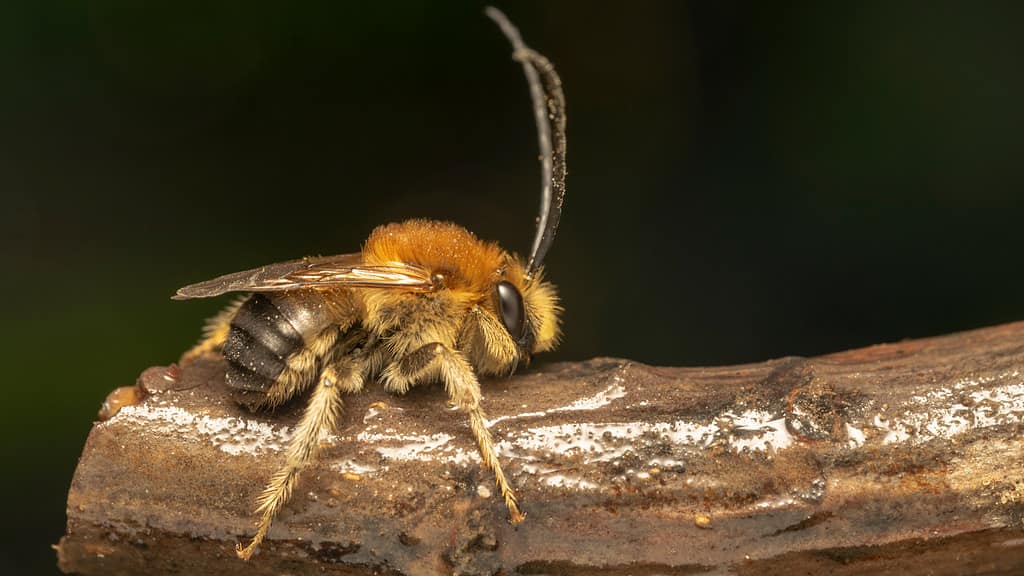
Long antennae distinguish long-horned bees from other bees.
©tasnenad/Shutterstock.com
With a name like theirs, you’d expect long-horned bees to be quite aggressive. The mid-sized, woolly longhorn bees are so named because of their long antennae, which give them a cute appearance.
Males of long-horned bees have unusually long antennae; in contrast, females have shorter antennae. These bees drill holes in the ground, where they build individual nests with wax-like brood cells that can hold a single egg and one pollen ball.
The nests, which can either be single or constructed in clusters, are frequently covered in brush. Females have stingers; males do not. They may sting you if you approach them aggressively. The sting is less than pleasant, landing them higher on Schmidt’s pain scale.
3. Bumble Bees
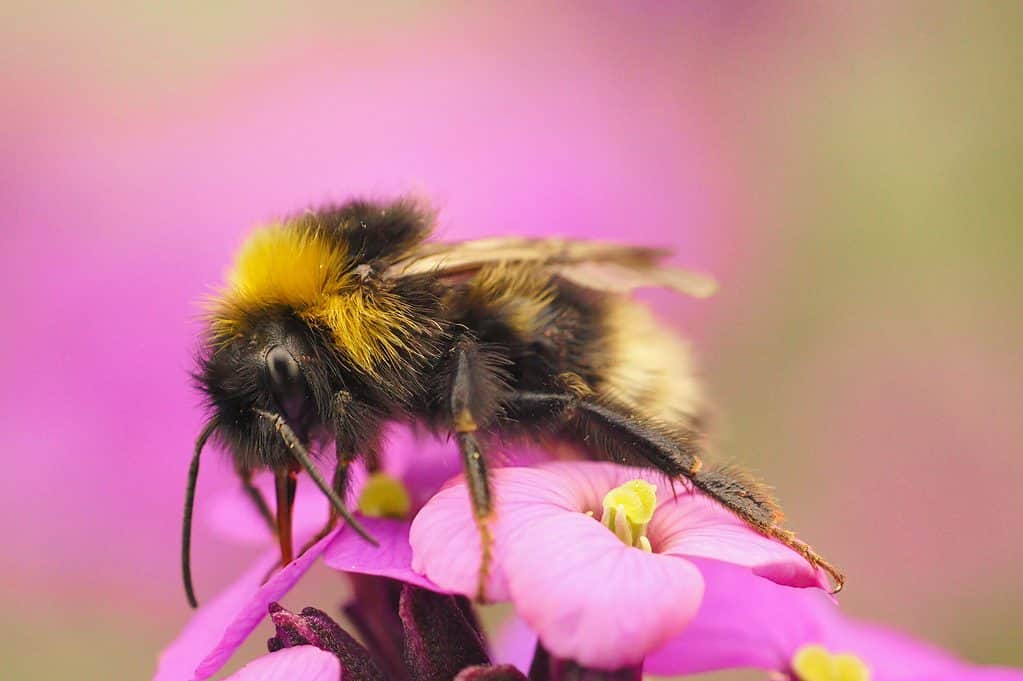
Being active for such a long span of time each year, bumble bees find sustenance from a wide variety of plant species.
©HWall/Shutterstock.com
Bumble bees are valuable pollinators of both agricultural and wild-blooming plants. They are omnivorous foragers and do not specialize in any particular bloom. As pollinators, bumble bees have wide-ranging ecological effects that can have an impact on Tennessee’s ecosystem.
Bumble bees are omnivores and are frequently the first and last bees to become productive from February through November. Because they are active for such a long period of time, they must be able to graze on a variety of plant species in a variety of climates to sustain a colony.
Although bumble bees can bite, it’s not their preferred method of defense and is not likely to be very painful. However, you will certainly know if you have been stung! Males, who are rarer, smaller, and discovered near the conclusion of the hive’s growth, are unable to sting, unlike queens and workers.
2. Large Carpenter Bees
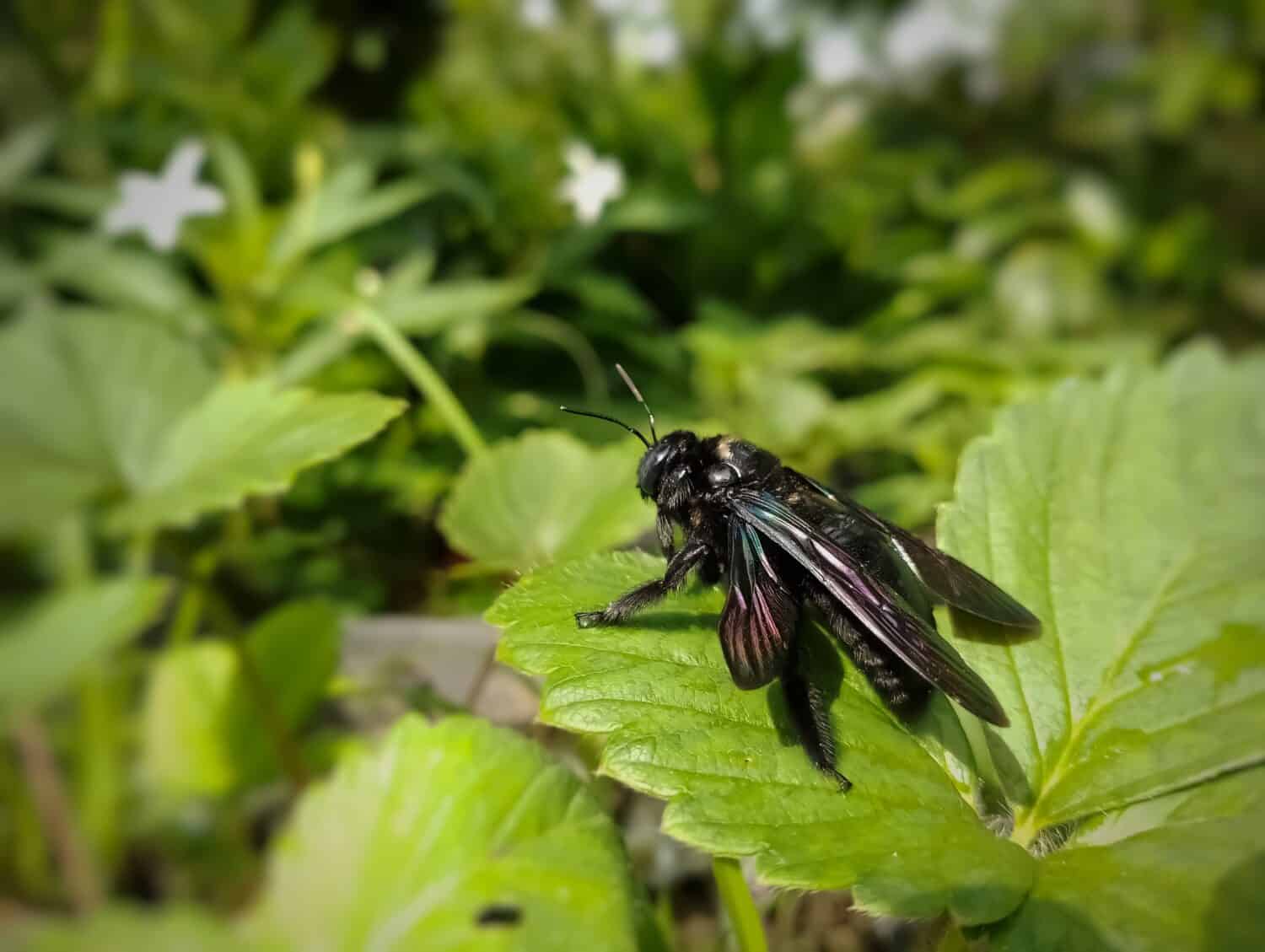
By drilling into wood, large carpenter bees make nests to raise their young.
©Ramligallery/Shutterstock.com
In Tennessee, huge, black bees are frequently seen hovering about the exterior of houses throughout the spring. These are probably carpenter bees, so named because they like to drill holes in wood to raise their young.
Carpenter bees favor old, unpainted wood, particularly softer types. Carpenter bees can harm structures and inflict aesthetic harm, though they are rarely as devastating as termites. Like honey bees and bumble bees, carpenter bees don’t reside in colonies.
A male carpenter bee is most likely approaching you if it is vigorously buzzing and darting around. Carpenter bee males will put on a frightening act as a kind of defense because they lack stingers.
Carpenter bee females can sting multiple times and do have stingers that have venom. You won’t likely see a female until you disturb her nest because she usually stays close to her eggs. Carpenter bee females won’t sting unless they are specifically provoked.
1. European (Western) Honey Bees
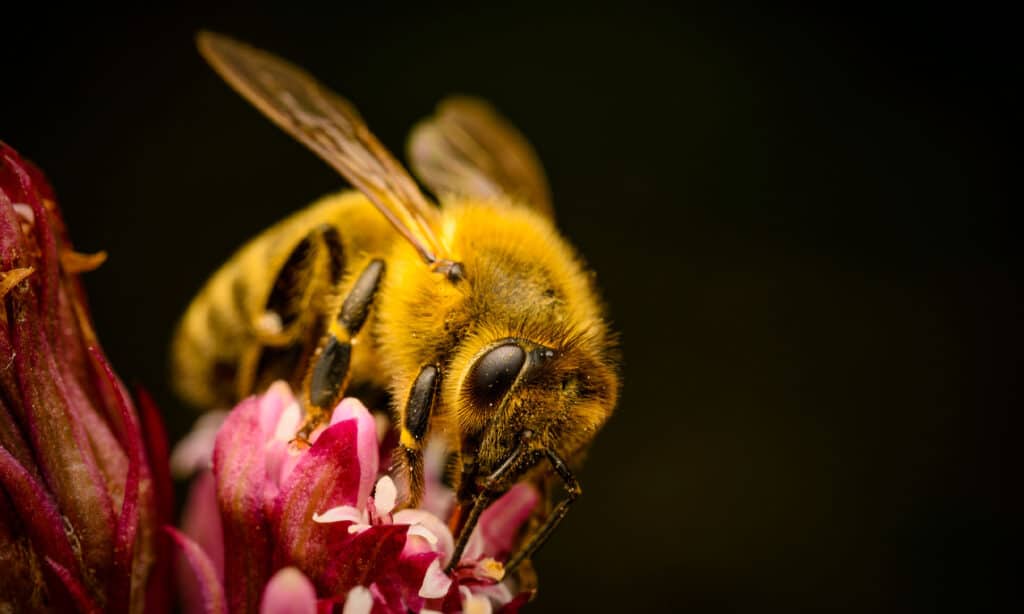
While their sting is particularly painful, European honey bees don’t sting unless they feel threatened.
©iStock.com/Jan Rozehnal
The most prevalent of the seven to twelve species of honey bees found globally is the western honey bee, sometimes known as the European honey bee. One of the earliest insects to be tamed was the western honey bee, which beekeepers continue to preserve as their principal species for both honey-making and pollination purposes.
The western honey bee currently lives on all continents but Antarctica thanks to human intervention. A slight to moderate risk from honey bees exists for people. When left alone, they are calm and won’t sting until they sense danger or damage to the hive.
The immediate, acute searing sensation at the stung site is one of the most common mild bee sting symptoms. Although these bees don’t sting unless provoked, it’s likely a feeling you won’t forget in the near future.
Treating Bee Stings
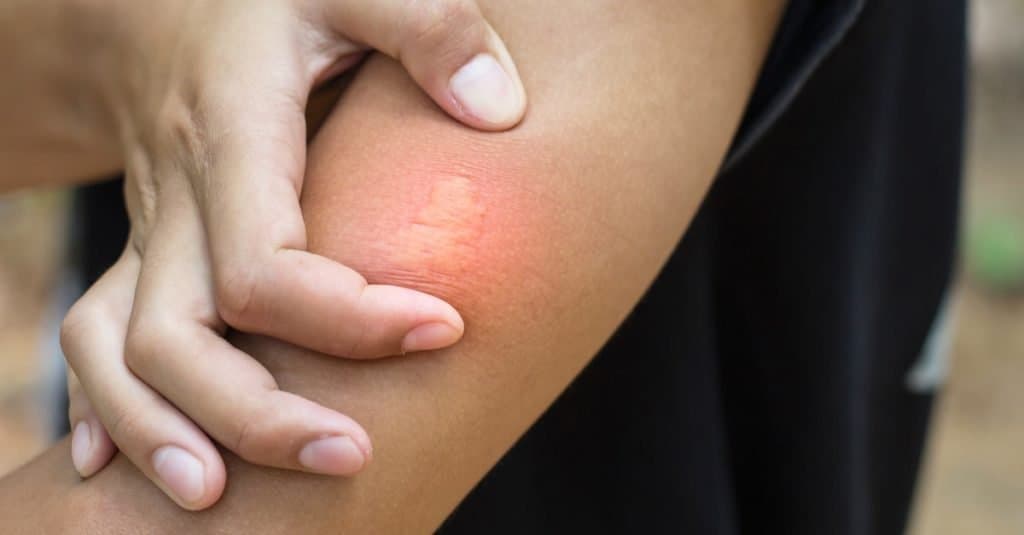
Bee stings are rarely a threat to human life, provided the victim is not allergic.
©WIRACHAIPHOTO/Shutterstock.com
Although bee and wasp stings are extremely painful, they rarely pose a threat to human life or health. This is, of course, if you’re not allergic. If you are allergic and happen to get stung by a bee, please seek medical attention immediately.
If you’re not allergic, follow the next steps to ease the pain and start the healing process after a bee sting.
Remove the Stinger
Some bees, like honey bees, leave their stinger inside you. After they sting, wasps, hornets, and yellow jackets don’t die. Therefore, if a honey bee stings you, get rid of the stinger as soon as you can. Avoid attempting to find a pair of tweezers if it means wasting any time.
Alternatively, use the edge of a credit card or your fingertips. Turn the stinger out to the side. Remove it quickly to prevent more venom injection into the skin. Your body will respond to venom more strongly the more of it is there.
Use a Cold Compress
Ice works wonders to ease pain and inflammation. It’s among the greatest at-home treatments for the sting during the first few days of treatment. Ice is the most efficient household item for treating sting symptoms, even if some individuals vouch for toothpaste or mud.
Antihistamines
Calamine lotion and other over-the-counter antihistamine medications can be beneficial. Antihistamine and topical steroid anti-itch products are excellent since the topical anesthetic numbs the area and relieves pain.
Oral antihistamines are helpful if you consistently experience inflammation and redness over a significant area of skin since they increase the antihistamine action in your body.
Potential Infections
Despite the rarity of sting site infections, keep a lookout for developing signs. If you experience inflammation, redness, and a fever over a period of days, you most certainly have a bacterial infection and require antibiotic treatment.
Prevent Getting Stung
Giving these small critters some room while maintaining your distance will help you prevent many possible stings. Children should be warned to be cautious around flowers; if you encounter bees or wasps, avoid hitting them; instead, quietly back away from the bee. Picking odorless cosmetics and lotions, sealing food left outside, and dressing in muted colors can all help keep you safe.
Summary of 14 Bees in Tennessee
| Rank | Bee | Characteristics |
|---|---|---|
| 1 | European (Western) Honey Bee | Sting is painful, but only sting if threatened; most prevalent bee species worldwide |
| 2 | Large Carpenter Bee | Drill holes in wood to raise their young, favoring older, softer wood; males are aggressive but don’t have stingers; females can sting repeatedly and have venom |
| 3 | Bumble Bee | Important pollinators; omnivores; must graze on a variety of plants; only females sting |
| 4 | Long-horned Bee | Named for cute, long antennae; drill holes in the ground, where they build individual nests; only females can sting |
| 5 | Masked Bee | Build their nests in reeds, tree limbs, and twigs; face looks like wearing a mask |
| 6 | Cuckoo Bee | Look like wasps; have thicker, more potent stings, larger, stronger mandibles, and a hardened abdomen |
| 7 | Small Carpenter Bee | Females collect pollen and nectar from 25 plant families |
| 8 | Miner Bee | robust, hairy bodies similar to bumble bees; ground nesters; rarely sting |
| 9 | Leafcutter Bee | Use tiny leaf cutouts to fill the nest cells in their hives; build tunnels in soil and decaying wood |
| 10 | Polyester Bee | Active dusk to dawn; solitary; expert pollinators |
| 11 | Digger Bee | Build their nests underground; 70 species; eat dangerous insects |
| 12 | Mason Bee | Solitary, tunnel-nesting pollinators; seldom sting |
| 13 | Sweat Bee | Drawn to perspiration; mild sting |
| 14 | Squash Bee | Pollinators of many squashes, including acorn and zucchini; only female can sting |
The photo featured at the top of this post is © olko1975/Shutterstock.com
Thank you for reading! Have some feedback for us? Contact the AZ Animals editorial team.







